Stand Back, I’m Going to Try Science!
My father is a chemical engineer at a large company. He volunteers in an outreach program where the company gives him science demonstrations aimed at precocious elementary schoolers, and he periodically goes to schools and birthday parties and stuff to show how neat science is. One of the kits he does is all about cryogenics, where he gets about a gallon of liquid nitrogen (LN2), and demonstrates what happens to things when you freeze them really cold. He talks about how matter can be a gas, a liquid, or a solid, and how its properties change as it goes from one state to another and changes temperature (racquetballs become brittle, flowers become crumbly, small amounts of LN2 boil into large amounts of nitrogen gas, etc).
He did a demonstration a couple days ago, and still had some LN2 left over from it. Ordinarily he just pours the rest out on the street (it boils away quickly, and no one notices since air is already about 78% nitrogen). However, this time we convinced him to keep it around for a few days so we can try freezing other things. I didn’t have my camera turned on for all of it, but I got shots of most of the things we did. Many of the pictures didn’t come out well because I just had my camera phone, with no flash and a very slow shutter speed. I’ve uploaded all the pictures, though I don’t know if I’ll go through and label them all with exactly what they are.
I should start off by saying a bit more about LN2. It’s a clear, colorless liquid. and it’s cold. Like, really, really cold. It boils into the gas we all know and love at a chilly -196°C (about -321°F, if you use silly units). To put that into perspective, the temperature difference between liquid nitrogen and ice water is nearly twice as big as the difference between ice water and boiling water. This stuff is cold!
SAFETY NOTE: If you manage to get your own LN2, remember to be careful. Wear safety goggles so it doesn’t accidentally splash into your eyes. Get thick leather gloves so you don’t freeze your hands (and keep them dry! If you get them wet, they’ll freeze to your fingers). If you care about your table, put a big piece of wood on top of it, so it doesn’t get covered with frost and have stuff frozen onto it. and be very careful what tools you use with LN2! Many plastics and metals become brittle and shatter easily at these temperatures, including steel. Do not trust the spatula and Pyrex measuring cup you found in your kitchen. Get real equipment from someone who knows what they’re doing. The person from whom you got your LN2 probably knows what equipment will withstand the temperatures and what won’t; try asking him/her for advice.
Anyway, on to the results. Here’s Dad pouring some LN2 from its insulated container into a beaker as Marc looks on.

Although nitrogen gas is normally clear, when it is cold and in high concentrations it can make fog (the way water can make fog, even though water vapor is normally clear).

The most frustrating part about the fog was that when you tried to blow it away so you could see what you were doing, your warm breath only made the LN2 boil faster, which made even more fog than you started with. To get rid of it, you just had to wait until most of the LN2 in the beaker had boiled away.
We first tried pouring some water into the LN2. Oddly enough, the water typically formed ice with one large bubble in it (presumably filled with nitrogen gas). As it warmed up, the gas would expand, and the bubble would spontaneously shatter.

On the right, you can see where a huge bubble popped even before we got it out of the beaker. Other times, it wouldn’t pop until after we got it out, which had very energetic results like those on the left (the very first time we fished anything out, we were holding it in a measuring cup looking at it, and 5 seconds later the ice spontaneously shattered, which startled us all). When the bubble burst in the LN2, it would often start with a small crack (presumably) where nitrogen could squeeze out, which caused popping sounds. As the crack widened, the pops would come faster and faster, until it was more of a buzzing sort of noise. Then the whole bubble would shear off, and the noise would stop.
The water ice was unusual in that it had fairly large faces where pieces cleaved off from one another. They were very smooth, and kinda reminded me of glaciers. I don’t think we quite managed to make ice XI (for reference, “normal” ice is ice Ih), since it typically needs temperatures below 72°K (and we were up at 77°K or thereabouts), but we were close.
Next up was canola oil. Although it froze in blueberry-sized drops (still that clear faint-yellow color, but scored with many cracks), the drops were very brittle and shattered into tiny pieces at the slightest touch (such as the spoon trying to fish them back out). Watching it re-melt was strange: it looked just like you’d expect, in that it was kinda like crushed ice melting into a yellowish pool. Unfortunately, my pictures didn’t turn out.
We tried milk, which stayed together in one large piece.
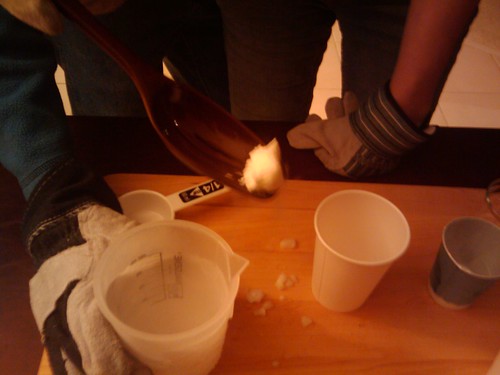
It was completely opaque, and whiter than usual (perhaps the milkfat congealed?). Unlike the water ice, its surface had lots of small faces, but they were big enough that I would still call its surface smooth.
We tried isopropanol (rubbing alcohol). I wouldn’t exactly say that it was brittle; it practically crumbled when touched, even moreso than the canola oil. There were several large chunks in the beaker, but once we fished them out with the spoon, all that was left were tiny pieces.
Dishwasher detergent is apparently inhomogeneous, in that parts of it were clear and parts were white. It also formed into lots of small, convoluted shapes.

Some of the pieces had bubbles in them like the water ice, which burst in a similar manner when they warmed up.

By this point, the outside of the beaker was covered with frost. You could pick up the beaker and tap it against the table, and snow would fall off of it. It was pretty neat, but between the frost and the fog you could barely see anything inside (particularly when you just put something new in, and the nitrogen boiled more vigorously than usual because the new thing was so warm).
Since the dishwasher detergent made some bubbles, we decided that we should mix it with water, and try pouring some LN2 into that. Oh, man, it was awesome!

The suds bubbled up and then froze in place! As the bubbles warmed up, the nitrogen within would expand and the bubbles would pop. However, since they were frozen, when one side popped the other sides of the bubble would remain, and eventually you’d be left with this scaffolding of where the bubbles used to be. You could even take a chopstick and poke the suds: it would sort of crinkle and fold in on itself, but even after puncturing it, the bubble would remain. It was great.
It’s strange to see a clear, colorless, odorless gas and know it’s not air. Here’s Ariana wishing she were on this side of the beaker so she could see the nitrogen bubble under the ice (you can also see the skeleton of some erstwhile suds on top):
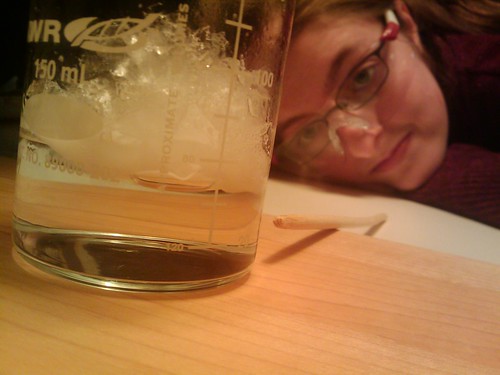
When the suds subsided, we were left with a layer of detergent-ice on top, which we managed to fish out.

You can see that indentation in the middle where the LN2 first impacted it. LN2 doesn’t easily mix with stuff because as it boils it floats on top of a layer of nitrogen (the way water droplets skitter across a hot frying pan). So, the weight of the LN2 made an impact on the surface, but the detergent surface stayed fairly smooth because the LN2 didn’t mix into it before it froze.
We were drinking poinsettias, so the next logical step was to put some triple sec in the LN2. This turned out to be the best one. It froze to the bottom of the beaker, and we couldn’t easily see it until all the LN2 boiled away.

At this point, it was mostly clear, with a bunch of cracks in it, and hard as ice (which was no surprise). There were some bubbles around the edges, but nothing too spectacular. However, as it warmed up it turned white!
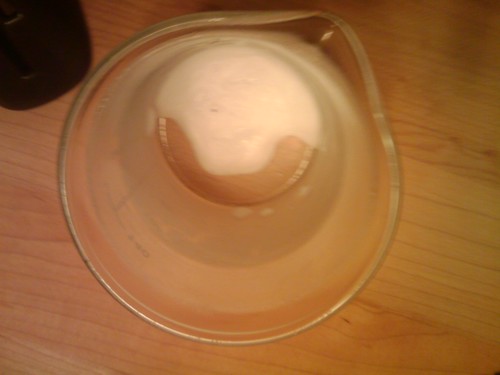
and it gets crazier than that. We touched it with the chopstick, and it had a consistency somewhere between wax and butter: you could deform it, but it took a bit of pressure to do so. We suspect the alcohol had melted but the water and other stuff (orange oil?) was still frozen, resulting in an amorphous solid (note that triple sec is 48 proof, and I can totally believe that it was roughly 3/4 frozen and 1/4 melted). We think it was completely crystalline through and through when it was clear, but when the alcohol melted it highlighted all the corners and edges of the water crystals, which is why it turned white. As it warmed up further, we could scoop it up with the chopstick and it would slowly drip back down.
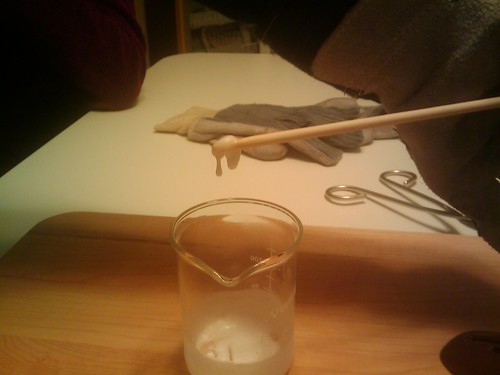
As it warmed up even further, it melted, and you could stir it.

Eventually, it warmed up more, and turned clear again. This somewhat surprised us, as all these changes to the triple sec were apparently temporary (so much so that we even repeated the entire thing a second time with that same sample!).
After the triple sec, we tried vinegar. It, too, must be more dense than LN2 because it started covering the bottom of the beaker, but froze before it covered the entire thing.

Odder still, it seemed to have contour lines etched into it. We’re not sure why that happened. Stuck to the side of the glass (towards the left of the image) are a couple tiny spheres of frozen vinegar (each is about 1mm in diameter), which are presumably droplets that splashed as they hit the LN2. They didn’t come out well in the photo, but at the time we were struck with how perfectly spherical they were.
We’re not sure why, but some parts of the frozen vinegar were more opaque than others.
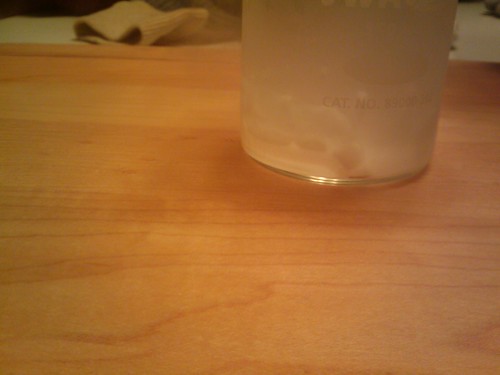
They sort of follow the contours of the vinegar (flat on the left and dropping off in the middle, since there’s no vinegar on the right), but we don’t know why it’s not a solid layer.
We tried a cleaning fluid similar to Formula 409 (we had a knockoff that claims to be better for the environment, but it’s a general cleaning agent for counters and stuff that comes in a spray bottle). We unscrewed the cap and poured some into the LN2.
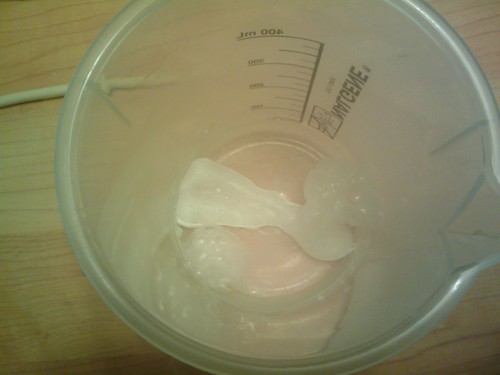
This was another surprise. There are two groups of (frozen) bubbles on the sides, and a strip of white stuff down the middle, but it froze before it could even spread out to the whole bottom of the beaker. The bubbles were crinkly like the ones from the dishwasher detergent. However, the surprise lay in the brittleness of the solid in the middle: when it was very cold (right when the LN2 boiled away), it was brittle and broke when I tried to scoop it up. After a couple minutes, however, it became hard enough that you could scoop it up (and even drop it in again!) without breaking it. Consequently, we concluded that even without a phase change, the properties of these chemicals can change based on temperature. Here’s a shot of the brittle pieces I broke on top of a cup, along with the skeleton of some of the bubbles which Dad speared with the chopstick:
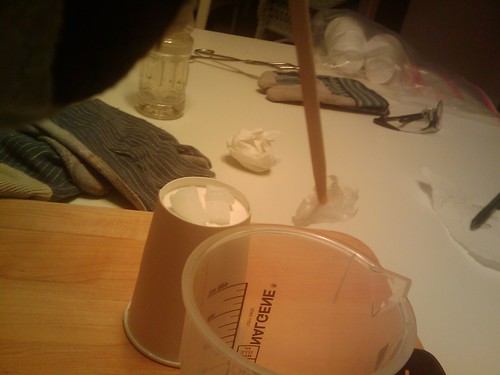
and here’s a larger piece of the cleaner that I got after it had warmed up and wasn’t brittle. You can see that it’s strong enough the bubbles didn’t fall off as I scooped it up:
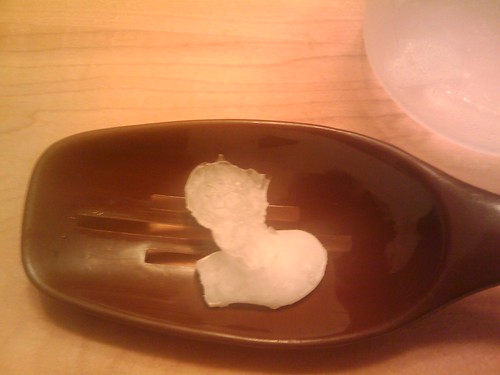
We decided to branch out from liquids, so we put some grape jelly in a beaker, and poured LN2 over it.

The water in it froze, and it became rock-hard and stuck to the beaker (to the point that we couldn’t even budge it when using the spoon as a crowbar and applying leverage). It was a little shiny, and reminded me of a grape Jolly Rancher. As it warmed up, it took on a milkier (though still purplish) color, and had the consistency of jello: if you poked it, it would wiggle back and forth, but eventually go back to its original shape. When it warmed up it became jelly-like again, and even regained its original color.
We tried aluminum foil, but there was no discernible change. Even when immersed in the LN2, it did not become brittle or hard or anything; it was still bendable but would keep its shape if you didn’t screw with it. In hindsight, this makes sense, since the LN2 comes in an aluminum container (lined with insulating foam, of course), and that container is designed to be unaffected by the temperatures.
We had such good luck with the triple sec, we decided to try vodka. Unfortunately, it was very boring.
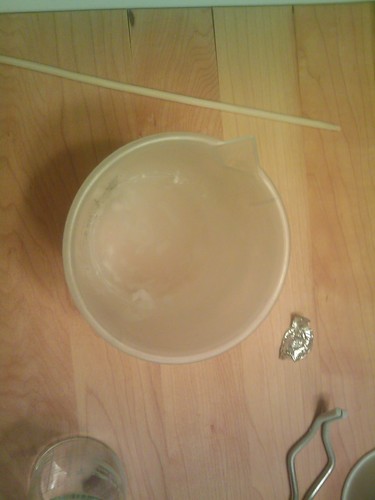
It was clear, it stuck to the bottom of the beaker, and when it melted it just turned into vodka again.
We were running out of LN2, so the last thing we tried was cranberry juice.

We think the edges froze first and are mostly water, which is why they’re whiter than the middle (which is where all the dissolved sugar and cranberry goodness went when the edges froze). This guess is backed up by the fact that the middle thawed first (suggesting it had higher concentrations of solvents than the edges). As it began to thaw, you could push it and have liquid come up to the surface. When most of it was melted, we noticed that the little solid left had huge ice crystals all lined up so it was striped (I didn’t get a picture of this; I wish I could have). We didn’t notice these striations before (and we would be surprised if such large crystals had been able to form with the LN2 cooling everything so quickly), so we suspect those ice crystals grew as the juice around them thawed and refroze.
I had a fantastic time playing with the liquid nitrogen, and I’m really glad I got pictures of most of what we did. If you ever get a chance to mess around with this stuff (chemistry majors, I’m looking at you), go for it!
Thanks for the photo-essay! This looks awesome!
I think LN2 is capable of turning the O2 in the air into liquid. I don’t remember exactly how to do it, but in an issue of Popular Science they explained how to collect liquid O2 to drop onto burning things.
Liquid oxygen make fire go BOOM!
You’re absolutely right. Carl von Linde was a German dude in the late 19th century who was working on a cutting edge technology, refrigeration. He experimented with ways to compress air (which heats it up), cool it to room temperature, and expand it again (which cools it down), which is pretty much the way modern refrigerators work. but here’s the trick he invented: if you then take a second bit of air, compress it, cool it to room temperature, then cool it down even more using the first batch of cool air you made and finally expand it again, you can get the new batch even colder than the previous one. You can repeat this process, getting colder and colder, until you get liquid air.
You’re also right that oxygen boils at a higher temperature than nitrogen, so if you have liquid air, you can boil off the nitrogen to get a liquid mixture that is over 90% oxygen. This lead to the invention of the acetylene torch, and then, as you say, fire go BOOM!
One of the demonstrations my dad does is he gets a volunteer to blow up a balloon, and he puts the balloon in the LN2. It collapses because much of the air turns to liquid (or solid, if it’s CO2), and the rest contracts per the Natural Gas Law. As it warms back up and reinflates, there’s a bit of time when the balloon has several ounces of liquid oxygen sloshing around the bottom.
more like ml of liquid O2, unless your dad is using weather balloons. 22.4L O2 gas ~ 32 ml liquid. Also, if you do this in the future, I recommend tennis balls – better than raquetballs, the felt helps them keep somewhat of a shape after they are smashed. Also, marshmallows are also fun – when frozen they can be easily ground into a powder, that when warmed up returns to its normal stickiness. Never thought of trying various oils in it though, that looks cool!
Thanks for pointing out that my “ounces” claim is wrong. It’s hard to judge how much stuff is inside a deflated balloon. I’ll pass along the tip about tennis balls; that sounds promising!
Dad froze some bite-sized marshmallows during the main demonstration, and we ate them cold (since they’re mostly air, it takes very little energy to warm them up again so it’s safe to feed them to elementary schoolers). They’re crunchy.
http://www.marriedtothesea.com/122308/lets-hear-it-for-chemists.gif